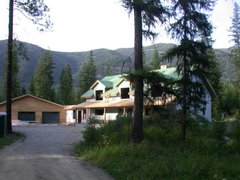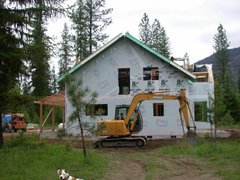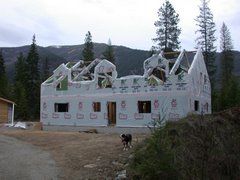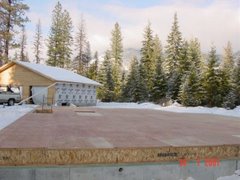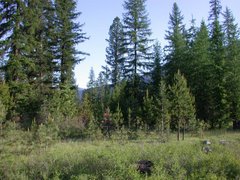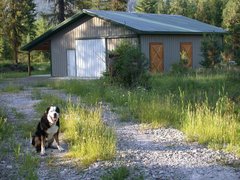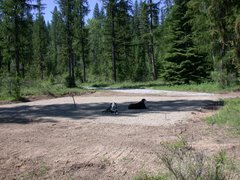
Our dogs share our lives, and thus our house. When we designed the Shorthorse lodge, we wanted it to be dog-friendly and unfussy. We also wanted easy maintenance and tough. I didn't want us heartbroken and cussing the dogs the first time we got toenail scratches on brand new doors or floors.
So here are some of the features we incorporated to make it a "dog house."
1. Ceramic tile floors in high-traffic areas. The tile is a slate-type gray, with matte finish and semi-rough surface for paw traction. Dogs love lying on cool tile floors on a hot day.
2. Cultured stone up to the window sills in the living room. Wouldn't show scuffs, claws, and dog goobers. The window sills would be stone (toenail-proof). We anticipate the dogs will be standing on them a lot, barking at the wildlife in the yard.
3. A "dog-proof room" that also serves as the laundry and mud room. We can shut them in there if we really have to on some rare occasion. Vinyl floors, easy-care cabinets, storage for dog food bins, and...a four-foot steel groming tub, complete with ladder and sprayer! The tub will also serve as a utility tub for washing horse blankets or whatever.
4. Two doggy doors in the breezeway; one accesses the laundry room, one accesses the back yard (which will be fenced with 5' chain link).
5. Hardwood flooring in two rooms, but it will be casual, almost pre-distressed.
6. A built-in dog bed nook in the living room. That was the architect's idea. Our dogs prefer to be on our bed, couch, or floor next to us, but maybe we can make this built-in thing work once in a while.
7. Front porch and back patio made of stamped concrete instead of wood or Trex. Again, scratch-proof and chew-proof.
8. Furniture that is "pre-distressed" and rustic.
9. Rustic doors, sort of Shaker style, that won't look ruined if they get scratched.
10. A three-stop elevator to help our elderly dogs get up and down the stairs (okay, so it's for us when we're lazy or lame...but the old dogs will use it too, as soon as they learn how to push the buttons).
Top photo of four dogs: our kids Grasel, Atlas, Lizzie, and Kosmo. Lizzie is a year-old pit bull. The other three are Greater Swiss Mountain Dogs. Kosmo is about 10 years old. Grasel and Atlas are littermates, 11 years old in this photo. We lost our little girl Grasel in May 2007, about two months after this photo was taken. Her ashes are waiting to be freed at Shorthorse, when we finally get moved later this year.




































